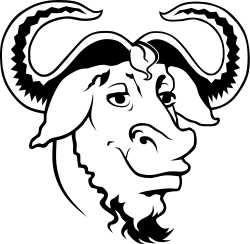GNU Affero General Public License
 | |
| Author | Free Software Foundation |
|---|---|
| Latest version | 3 |
| Publisher | Free Software Foundation, Inc. |
| Published | November 19, 2007 |
| DFSG compatible | Yes[1] |
| FSF approved | Yes[2] |
| OSI approved | Yes[3][4] |
| GPL compatible | Yes (permits linking with GNU GPLv3) [5] |
| Copyleft | Yes[2] |
| Linking from code with a different license | Only with GNU GPLv3. The GNU AGPL terms will apply for the GNU AGPL part in a combined work.[2][5] |
| Website |
www |
The GNU Affero General Public License is a free, copyleft license published by the Free Software Foundation in November 2007, and based on the GNU General Public License, version 3 and the Affero General Public License.
The Free Software Foundation has recommended that the GNU AGPLv3 be considered for any software that will commonly be run over a network.[2] The Open Source Initiative approved the GNU AGPLv3[3] as an open source license in March 2008 after the company Funambol submitted it for consideration.[6]
Compatibility with the GPL
GNU AGPLv3 and GPLv3 licenses each include clauses (in section 13 of each license) that together achieve a form of mutual compatibility for the two licenses. These clauses explicitly allow the "conveying" of a work formed by linking code licensed under the one license against code licensed under the other license,[7] despite the licenses otherwise not allowing relicensing under the terms of each other.[2] In this way, the copyleft of each license is relaxed to allow distributing such combinations.[2]
Examples of applications under GNU AGPL
Stet was the first software system known to be released under the GNU AGPL, on November 21, 2007,[8] and is the only known program to be used mainly for the production of its own license.
Flask developer Armin Ronacher noted in 2013 that the GNU AGPL is a "terrible success" as "vehicle for dual commercial licensing" and gave Humhub, MongoDB, OpenERP, RethinkDB, Shinken, Slic3r, SugarCRM, and WURFL as examples.[9]
Some of the best-known examples of GNU AGPL licensed software include:
- the NoSQL database BerkeleyDB
- the distributed social networking service Diaspora
- the application development and maintenance software Launchpad
- the cross-platform document-oriented database MongoDB
- the enterprise resource planning platform Odoo
- the file hosting services ownCloud
- the integrated development environment for the statistics language R, RStudio
See also
References
- ↑ Jaspert, Joerg (November 28, 2008). "ftp.debian.org: Is AGPLv3 DFSG-free?". The Debian Project. Retrieved December 1, 2008.
- 1 2 3 4 5 6 List of free-software licences on the FSF website: “We recommend that developers consider using the GNU AGPL for any software which will commonly be run over a network”.
- 1 2 "OSI approved licenses". Open Source initiative.
- ↑ "OSI approved", Licenses, TL;DR legal.
- 1 2 "Licenses section 13", GNU AGPLv3, GNU Project.
- ↑ "Funambol Helps New AGPLv3 Open Source License Gain Formal OSI Approval" (press release). Funambol. Mar 13, 2008.
- ↑ The GNU General Public License – GNU Project – Free Software Foundation (FSF)
- ↑ Kuhn, Bradley M. (November 21, 2007). "stet and AGPLv3". Software Freedom Law Center. Archived from the original on March 15, 2008. Retrieved June 14, 2008.
- ↑ Ronacher, Armin (2013-07-23). "Licensing in a Post Copyright World". lucumr.pocoo.org. Retrieved 2015-11-18.
The AGPLv3 was a terrible success, especially among the startup community that found the perfect base license to make dual licensing with a commercial license feasible. MongoDB, RethinkDB, OpenERP, SugarCRM as well as WURFL all now utilize the AGPLv3 as a vehicle for dual commercial licensing. The AGPLv3 makes that generally easy to accomplish as the original copyright author has the rights to make a commercial license possible but nobody who receives the sourcecode itself through the APLv3 inherits that right. I am not sure if that was the intended use of the license, but that's at least what it's definitely being used for now.
External links
- Official website GNU AGPL
- GPLv3, Software as a Service and version 2 of the Affero GPL
- Free Software Foundation supports AGPL press release
- Free Software Foundation GNU AGPL v3 press release
